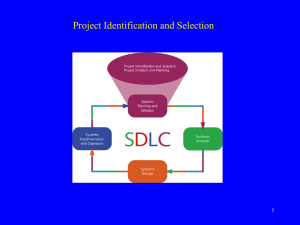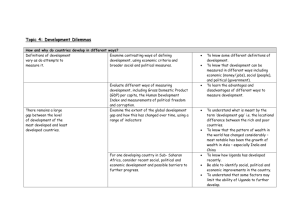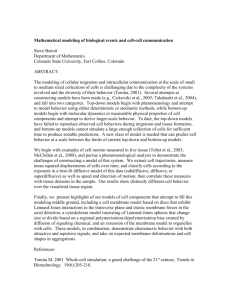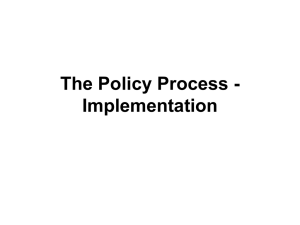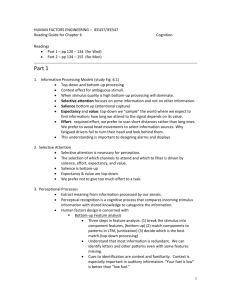Interactive approaches to second language reading
advertisement
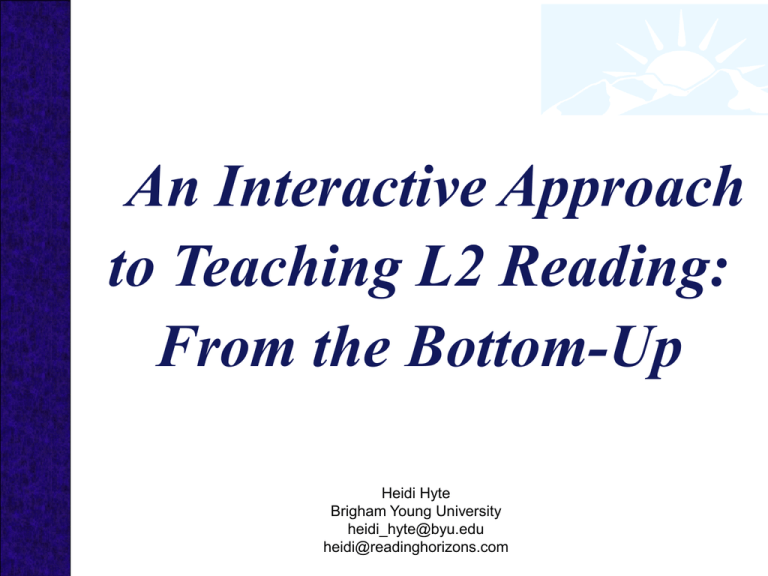
An Interactive Approach to Teaching L2 Reading: From the Bottom-Up Heidi Hyte Brigham Young University heidi_hyte@byu.edu heidi@readinghorizons.com Webinar Objectives • Provide examples of bottom-up, top-down, and interactive strategies for teaching L2 reading. • Provide practical methodology and approaches to teaching bottom-up strategies in L2 reading. • Offer rationale for the role of students’ phonemic awareness. • Offer rationale for the use of explicit, systematic bottom-up strategies instruction. What is reading? The ability to successfully generate meaning from text. What is fluent reading? What is fluent reading? “The ability to read at an appropriate rate with adequate comprehension” (68). Anderson, N. J. (2003). Exploring Skills: Reading. In D. Nunan (Ed.), Practical English Language Teaching (pp. 67-86). New York: McGraw-Hill. What is strategic reading? What is strategic reading? “The ability of the reader to use a wide variety of reading strategies to accomplish a purpose for reading” (68). Anderson, N. J. (2003). Exploring Skills: Reading. In D. Nunan (Ed.), Practical English Language Teaching (pp. 67-86). New York: McGraw-Hill. What is the goal of reading? Comprehension Factors that influence reading comprehension: Factors that influence reading comprehension: • The reader • The text • Interaction between the reader and the text: – – – – Strategies Schema Purpose for reading Manner of reading • Fluency Aebersold, J. & Field, M. L., (1997). From reader to reading teacher: Issues and strategies for second language classrooms. New York: Cambridge University Press. Models of Reading • Bottom-up processing (decoding) • Top-down processing • Interactive approach Bottom-up Processing Reader builds meaning from the smallest units of meaning to achieve comprehension. Example letters letter clusters words phrases sentences longer text meaning = comprehension Top-down Processing Reader generates meaning by employing background knowledge, expectations, assumptions, and questions, and reads to confirm these expectations. Example Pre-reading activities (i.e. activating schema, previewing, and predicting) + background knowledge (cultural, linguistic, syntactic, and historical) = comprehension Aebersold, J. & Field, M. L., (1997). From reader to reading teacher: Issues and strategies for second language classrooms. New York: Cambridge University Press. Interactive Approach Reader uses both bottom-up and topdown strategies simultaneously or alternately to comprehend the text. Example Reader uses top-down strategies until he/she encounters an unfamiliar word, then employs decoding skills to achieve comprehension. Aebersold, J. & Field, M. L., (1997). From reader to reading teacher: Issues and strategies for second language classrooms. New York: Cambridge University Press. Interactive Approach Knowledge base + bottom-up strategies + top-down strategies = comprehension Which model should be adopted? The reader must be competent in both bottom-up and top-down processing. Nunes, T. (1999). Learning to read: An integrated view from research and practice. Dordrecht, The Netherlands: Kluwer. Interaction (“balance”) of bottom-up and top-down strategies: Interaction (“balance”) of bottom-up and top-down strategies: Top-down Interaction (“balance”) of bottom-up and top-down strategies: Bottom-up Interaction (“balance”) of bottom-up and top-down strategies: Bottom-up Top-down Interaction (“balance”) of bottom-up and top-down strategies: Bottom-up strategies (“phonics” approach) ________________ Top-down strategies (“whole language” approach) ________________ Examples: Examples: • decoding • using capitalization to infer proper nouns • graded reader approach • pattern recognition • using background knowledge • predicting • guessing the meaning of unknown words from context • skimming/scanning Bottom-up Top-down Models of Reading: Application Top-down processing The kenlig coddlers canly kimpled in the cumpy kebs. 1) What kind of coddlers were they? 2) What did the coddlers do? 3) How did they do it? 4) Where did they do it? 5) In what kind of kebs did they kimple? 6) What is the subject? What is the verb? Models of Reading: Application Bottom-up processing The kenlig coddlers canly kimpled in the cumpy kebs. When do you spell words with a C or a K? • kenlig • coddlers • canly • kimpled • cumpy • kebs Decoding Strategy: The C and K Skill C – a, o, u K – i, e cat cob cup can kid Ken kin keg Models of Reading: Application Bottom-up processing The kenlig coddlers canly kimpled in the cumpy kebs. When do you spell words with a C or a K? • kenlig • coddlers • canly • kimpled • cumpy • kebs Top-down Strategies: Application Step 1: Read the title. Predict what the text is going to be about. Step 2: Ask questions: - What is your purpose for reading this text? - What type of text is this? (A newspaper article? A letter? A textbook? A poem?) - What is a “Jabberwocky”? Step 3: Activate background knowledge: What do you know about Lewis Carroll’s style of writing? Top-down Strategies: Application “Jabberwocky” By Lewis Carroll (from Through the Looking-Glass and What Alice Found There, 1872) Top-down Strategies: Application “Jabberwocky” By Lewis Carroll (from Through the Looking-Glass and What Alice Found There, 1872) `Twas brillig, and the slithy toves Did gyre and gimble in the wabe: All mimsy were the borogoves, And the mome raths outgrabe. Top-down Strategies: Application • Which top-down strategies did you use while reading to help you comprehend the text? • Were your top-down strategies enough to read the text? • What did you do when you came across an unfamiliar word? Bottom-up Strategies: Application How do you read these words? wabe brillig Bottom-up (Decoding) Strategies: Framework of Phonics: 42 sounds 5 phonetic skills 2 decoding skills Five Phonetic Skills * 1. met X Five Phonetic Skills * * 2. jump X Five Phonetic Skills 3. me X Five Phonetic Skills 4. smile X X Five Phonetic Skills 5. boat X X Five Phonetic Skills 1. 2. 3. 4. 5. * met * * jump me smile boat X X X X X X X Five Phonetic Skills How do you decode this word? wabe Five Phonetic Skills How do you decode this word? wabe X X Decoding Skill #1 motel Decoding Skill #1 1. mo X * 2. mot X 3. mote X X 4. motel X X Decoding Skill #1 motel X X One consonant (guardian) goes on Decoding Skill #1 provide X X X One consonant (guardian) goes on Decoding Skill #2 campus X X Two consonants (guardians) split Decoding Skill #2 How do you decode this word? brillig Decoding Skill #2 How do you decode this word? brillig X X Bottom-up Strategies: Application How do you read these words? wabe brillig The role of phonemic awareness What is phonemic awareness? • The consciousness that words are composed of separate sounds • The strategies used to: – Segment strings of sounds – Discriminate between these sounds The role of phonemic awareness Why is it important for ESL/EFL readers? The role of phonemic awareness Why is it important for ESL/EFL readers? “ESL and EFL learners need to acquire the knowledge base of English phonemes so that their aural discrimination of sounds can proceed effortlessly, quickly, and unconsciously” (53). Birch, Barbara M. (2002). English L2 Reading: Getting to the Bottom. New Jersey: Lawrence Erlbaum Associates, Publishers. The role of phonemic awareness Why is it important for ESL/EFL readers? “Phonemic awareness is an important precursor for alphabetic reading, but paradoxically people often acquire it as a result of learning to read an alphabet” (54). Birch, Barbara M. (2002). English L2 Reading: Getting to the Bottom. New Jersey: Lawrence Erlbaum Associates, Publishers. The role of phonemic awareness Why is it important for ESL/EFL readers? • Readers who have it are better readers. • Readers are able to connect sounds with symbols. • Readers can attach meaning to sounds. • If readers can associate the sounds of words when learning the meaning of new vocabulary, it sticks better. Application: Now What? 1) First provide explicit instruction in bottomup/decoding strategies, then allow opportunities to practice bottom-up strategies in extensive reading materials. Application: Now What? 2) Use shorter passages to teach intensive reading skills and longer texts to apply topdown strategies. Application: Now What? 3) Select materials for both intensive (teaching explicit strategies) and extensive (application of strategies) purposes. One single text generally cannot meet both needs. Application: Now What? 4) When teaching new vocabulary, provide explicit decoding strategies to enable learners to develop phonemic awareness. - rhyming games (mat pat) - manipulation of beginning, middle, and end of words (mat pat pet pen) Self Reflection Take a moment to ponder the answers to the questions on the following slide. As you answer these questions, think of your students’ needs. What kind of strategies do you need to equip your students with in order to help them achieve the goal of comprehension? Self Reflection 1) What strategies do YOU use to teach reading? Self Reflection 1) What strategies do YOU use to teach reading? 2) When you learned how to read, did you learn both bottom-up and top-down skills? Self Reflection 1) What strategies do YOU use to teach reading? 2) When you learned how to read, did you learn both bottom-up and top-down skills? 3) When you teach reading, do you rely more on teaching top-down strategies? If so, why? Self Reflection 1) What strategies do YOU use to teach reading? 2) When you learned how to read, did you learn both bottom-up and top-down skills? 3) When you teach reading, do you rely more on teaching top-down strategies? If so, why? 4) Are you an interactive reading teacher? Why bottom-up? “Despite the emergence of interactive models, I am concerned that much of the second language reading literature continues to exhibit a strongly top-down bias… This research has resulted in many useful insights, but the lack of attention to decoding problems has, I think, produced a somewhat distorted picture of the true range of problems second language readers face” (95). Eskey, D. (1993). Holding in the bottom: An interactive approach to the language problems of second language readers. In P. Carrell, J. Devine, & D. Eskey (Eds.), Interactive approaches to second language reading (pp. 93-100). Cambridge, England: Cambridge University Press. Why bottom-up? “In practical terms, my concern is thus to keep the language in the teaching of second language reading. That may not sound very controversial, but I think that in promoting higher-level strategies-like predicting from context or the use of schemata and other kinds of background knowledge--some researchers have been sending a message to teachers that the teaching of reading to second language readers is mostly just a mater of providing them with the right background knowledge for any texts they must read, and encouraging them to make full use of that knowledge in decoding those texts. Though that is certainly important, it is also, I think, potentially misleading as a total approach…We must not, I believe, lose sight of the fact that language is a major problem in second language reading, and that even educated guessing at meaning is not a substitute for accurate decoding” (97). Eskey, D. (1993). Holding in the bottom: An interactive approach to the language problems of second language readers. In P. Carrell, J. Devine, & D. Eskey (Eds.), Interactive approaches to second language reading (pp. 93-100). Cambridge, England: Cambridge University Press. What’s your opinion? “[The introduction of top-down processing] has had such a profound impact [on second language reading] that there has been a tendency to view the introduction of a strong top-down processing perspective as a substitute for the bottom-up, decoding view of reading, rather than its complement” (3-4). Carrell, P. (1993). Introduction: Interactive approaches to second language reading. In P. Carrell, J. Devine, & D. Eskey (Eds.), Interactive approaches to second language reading (pp. 1-7). Cambridge, England: ambridge University Press. Sources Aebersold, J. & Field, M. L., (1997). From reader to reading teacher: Issues and strategies for second language classrooms. New York: Cambridge University Press. Anderson, N. J. (2003). Exploring Skills: Reading. In D. Nunan (Ed.), Practical English Language Teaching (pp. 67-86). New York: McGraw-Hill. Birch, B. M, (2002). English L2 Reading: Getting to the Bottom. Mahwah, New Jersey: Lawrence Erlbaum Associates. Carrell, P. (1993). Introduction: Interactive approaches to second language reading. In P. Carrell, J. Devine, & D. Eskey (Eds.), Interactive approaches to second language reading (pp. 1-7). Cambridge, England: Cambridge University Press. Eskey, D. (1993). Holding in the bottom: An interactive approach to the language problems of second language readers. In P. Carrell, J. Devine, & D. Eskey (Eds.), Interactive approaches to second language reading (pp. 93-100). Cambridge, England: Cambridge University Press. Nunes, T. (1999). Learning to read: An integrated view from research and practice. Dordrecht, The Netherlands: Kluwer.
